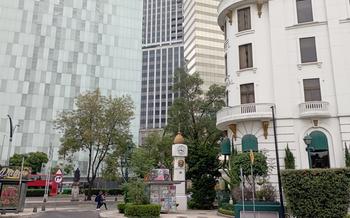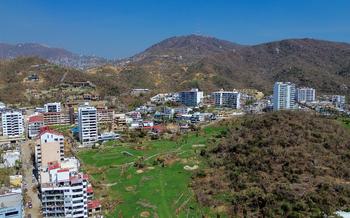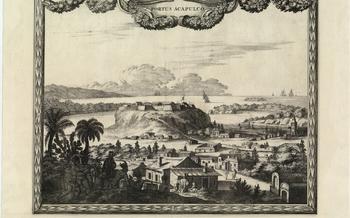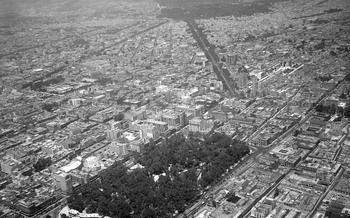
Diana the Huntress Fountain
- Diana the Huntress Fountain: An Ode to Beauty and Strength
- A Glimpse into Acapulco's Cultural Heritage
- A Masterpiece of Mexican Architecture
- The Allure of the Diana Fountain at Night
- Unveiling the Fountain's History
- A Popular Destination for Tourists and Locals Alike
- Capturing the Perfect Shot
- The Fountain as a Gathering Place
- Preserving a Cultural Treasure
- The Fountain's Enchanting Surroundings
- A Symbol of Transformation and Progress
- Insider Tip: The Best Time to Visit
Diana the Huntress Fountain: An Ode to Beauty and Strength
Historical Significance: The Diana the Huntress Fountain stands as a significant landmark in Acapulco, Mexico. Unveiled in 1970 as a tribute to the Roman goddess Diana, this captivating fountain has become an iconic symbol of the city. Its historical significance lies in its representation of Acapulco's cultural heritage and its transformation from a small fishing village to a vibrant tourist destination.
Architectural Features: The fountain showcases a harmonious blend of traditional and contemporary architectural styles. Designed by renowned Mexican architect Vicente Mendiola Quezada, it features a bronze sculpture of the goddess Diana atop a white marble pedestal. The sculpture captures Diana's poise and strength, embodying the essence of the Roman deity.
Symbolism and Mythology: Diana, the Roman goddess of the hunt, nature, and childbirth, is revered for her strength, independence, and femininity. The fountain symbolizes these attributes, projecting a powerful message of empowerment and resilience. It celebrates the goddess's connection with nature, representing her role as the protector of animals and the wilderness.
Location and Accessibility: The Diana the Huntress Fountain is strategically situated on the scenic Costera Miguel Alemán, Acapulco's main boulevard. Its prominent location makes it easily accessible for tourists and locals. The fountain's proximity to the beach, restaurants, and shops further enhances its appeal as a popular attraction.
A Glimpse into Acapulco's Cultural Heritage
The Diana the Huntress Fountain is not just a stunning work of art but also holds a significant place in Acapulco's cultural fabric. It stands as a symbol of the city's rich history and unique identity, bridging the past and the present. For locals, the fountain is a source of pride and a reminder of their cultural heritage. It serves as a gathering place for celebrations, protests, and special occasions, embodying the community spirit that defines Acapulco.
For visitors, the fountain offers a glimpse into the city's vibrant culture. Its blend of traditional and contemporary elements showcases Acapulco's ability to embrace modernity while honoring its roots. The fountain's symbolism of strength, independence, and femininity resonates with people from all walks of life, making it a beloved landmark for both locals and tourists alike. It encapsulates the essence of Acapulco's cultural heritage, inviting visitors to explore the city's diverse artistic traditions and vibrant spirit.
A Masterpiece of Mexican Architecture
The Diana the Huntress Fountain is a remarkable example of Mexican architecture, showcasing unique design elements that blend traditional and contemporary styles. Its distinctive features include:
-
Curved Lines and Fluid Forms: The fountain's design is characterized by graceful curves and fluid forms, creating a sense of movement and dynamism. The flowing lines mimic the movement of water, enhancing the fountain's connection to its natural surroundings.
-
Incorporation of Local Materials: The fountain is constructed using locally sourced materials, such as bronze and granite, showcasing the region's rich craftsmanship and natural resources. The use of these materials adds a sense of authenticity and connection to the local culture.
-
Fusion of Styles: The fountain seamlessly blends traditional Mexican motifs with contemporary design elements, creating a unique and captivating aesthetic. The incorporation of traditional symbols and patterns pays homage to Mexico's cultural heritage, while the modern elements add a touch of sophistication and modernity.
-
Collaboration of Renowned Artists: The fountain is the result of a collaborative effort between renowned Mexican architects and artists, including Juan Fernando Olaguíbel, Enrique Carbajal, and Sebastián. Their combined expertise and artistic vision resulted in a masterpiece that has become an iconic symbol of Acapulco.
The Allure of the Diana Fountain at Night
As darkness descends upon Acapulco, the Diana Fountain transforms into a mesmerizing spectacle of light and shadow. Illuminating the fountain's intricate details and cascading waters, the special effects create an enchanting ambiance that draws visitors and locals alike. The interplay of light and water generates a dramatic atmosphere, enhancing the fountain's visual appeal and creating a captivating scene for evening strolls and photography. The illuminated fountain becomes a central attraction, adding to the vibrant nightlife of Acapulco and offering a unique experience for those seeking a blend of beauty, culture, and entertainment.
Unveiling the Fountain's History
The Diana the Huntress Fountain was conceived and constructed in 1990, during the presidency of Carlos Salinas de Gortari. Its creation was part of a broader effort to beautify and modernize Acapulco, which was then undergoing rapid development as a popular tourist destination. The fountain was designed by renowned Mexican architect and sculptor Enrique Carbajal González, also known as Sebastian. Carbajal, who is known for his monumental sculptures and public art installations, drew inspiration from the rich history and culture of Mexico to create this masterpiece. The fountain was inaugurated on December 1, 1990, and quickly became a symbol of Acapulco's transformation into a modern and cosmopolitan city.
A Popular Destination for Tourists and Locals Alike
The Diana the Huntress Fountain is a beloved landmark that attracts both tourists and locals alike. Its iconic status and cultural significance make it a must-see destination for visitors to Acapulco. Tourists are drawn to the fountain's stunning beauty, historical significance, and symbolic representation of the city. They marvel at its intricate design, admire its symbolism of strength and femininity, and capture countless photos to share with friends and family.
For locals, the fountain holds a special place in their hearts. It is a symbol of Acapulco's unique identity, a source of pride, and a reminder of the city's rich cultural heritage. Locals gather at the fountain for celebrations, special occasions, and protests, demonstrating its role as a social hub and a symbol of unity. The fountain's popularity is a testament to its enduring appeal and its status as a beloved landmark in Acapulco.
Its inclusion in tour itineraries and promotional materials further solidifies its position as a symbol of Acapulco's tourism industry and cultural significance. The fountain's presence in these materials showcases its importance to the city and entices visitors to experience its beauty and symbolism firsthand. The Diana the Huntress Fountain is a true gem of Acapulco, captivating the hearts of tourists and locals alike.
Capturing the Perfect Shot
The Diana the Huntress Fountain offers a wealth of opportunities for photographers to capture stunning images. The fountain's grandeur, symbolism, and intricate details make it a captivating subject for photography enthusiasts. To capture the fountain's essence, photographers should consider the following tips:
-
Choose the Right Angle: Experiment with different angles to find the most flattering perspective. Shooting from a low angle can emphasize the fountain's height and majesty, while a higher angle can provide a broader view of the surrounding area.
-
Consider the Lighting: The fountain's appearance changes dramatically throughout the day. Early morning and late afternoon light can create warm, golden tones, while midday light produces sharp shadows and highlights the fountain's details.
-
Use a Tripod: A tripod is essential for capturing sharp, blur-free images, especially when shooting in low-light conditions.
-
Play with Shutter Speed: Experiment with different shutter speeds to create dynamic effects. A slow shutter speed can blur the water's movement, creating a sense of motion, while a fast shutter speed can freeze the water droplets in mid-air.
-
Capture the Details: Don't forget to zoom in and capture the fountain's intricate details, such as the goddess Diana's facial expression, the flowing water, and the surrounding sculptures.
-
Share Your Photos: Share your stunning fountain photos on social media and travel blogs to inspire other travelers and showcase Acapulco's beauty to the world.
The Fountain as a Gathering Place
The Diana the Huntress Fountain serves as a significant meeting point and social hub in Acapulco. Locals and tourists alike gather around the fountain to socialize, relax, and enjoy the scenic surroundings. The fountain's central location and iconic status make it an ideal spot for friends to meet, couples to rendezvous, and families to spend quality time together.
Throughout the year, the fountain plays host to a variety of events, protests, and celebrations. From lively concerts and art exhibitions to peaceful demonstrations and cultural festivals, the fountain provides a vibrant backdrop for community gatherings. During these events, the fountain transforms into a stage, where performers showcase their talents and attendees come together to celebrate Acapulco's diverse culture and traditions.
The Diana Fountain symbolizes unity and community spirit in Acapulco. It represents a shared space where people from all walks of life can come together, fostering a sense of belonging and connection. The fountain's enduring presence and popularity underscore its importance as a gathering place and a cherished landmark in the city.
Preserving a Cultural Treasure
The Diana the Huntress Fountain, a beloved landmark of Acapulco, requires constant care and attention to maintain its original beauty and grandeur. Local authorities and organizations have undertaken significant efforts to preserve and restore the fountain, ensuring its continued existence for future generations. Regular cleaning, maintenance, and repairs are carried out to address the effects of time, weather, and environmental factors. The fountain's intricate details, vibrant colors, and overall structure are meticulously preserved, using traditional techniques and materials that respect its historical significance. The preservation of the Diana Fountain is not merely a task but a testament to Acapulco's commitment to safeguarding its cultural heritage and ensuring that this iconic landmark remains a source of pride and inspiration for both locals and visitors.
The Fountain's Enchanting Surroundings
The Diana the Huntress Fountain is situated along the scenic Costera Miguel Alemán, a vibrant and bustling avenue that stretches along Acapulco's coastline. Surrounded by lush tropical vegetation, the fountain becomes a captivating sight against the backdrop of the sparkling Pacific Ocean.
In close proximity to the fountain, visitors can find an array of attractions to enhance their experience. Numerous restaurants, cafes, and bars line the Costera, offering delicious local cuisine, refreshing beverages, and panoramic views of the ocean. For those seeking retail therapy, a variety of shops and boutiques are within easy reach, showcasing local crafts, souvenirs, and designer goods.
The fountain's location also makes it an ideal starting point for exploring Acapulco's many other attractions. The famous La Quebrada cliffs, where daring divers showcase their skills, are just a short walk away. The Acapulco Historical Museum, which houses fascinating exhibits on the city's rich history and culture, is also nearby. The vibrant nightlife of Acapulco, with its numerous nightclubs, bars, and live music venues, is easily accessible from the Costera Miguel Alemán.
Whether you're seeking relaxation, entertainment, or cultural exploration, the Diana the Huntress Fountain and its enchanting surroundings offer something for everyone. Immerse yourself in the vibrant atmosphere, indulge in local delicacies, shop for unique souvenirs, and create lasting memories in this captivating destination.
A Symbol of Transformation and Progress
The Diana the Huntress Fountain is not just a beautiful work of art; it also holds a profound significance as a symbol of Acapulco's transformation and progress. Once a small fishing village, Acapulco has evolved into a vibrant tourist destination and a symbol of modern Mexico. The fountain stands as a testament to the city's embrace of modernity and tourism, while still honoring its rich cultural heritage. It reflects Acapulco's commitment to preserving its unique identity while embracing progress and development. The fountain inspires the city to continue to strive for excellence and innovation, while staying true to its roots. It is a symbol of hope and optimism for the future of Acapulco, representing the city's potential for continued growth and prosperity.
Insider Tip: The Best Time to Visit
To fully experience the magic of the Diana the Huntress Fountain, plan your visit for the early evening. As the sun begins to set, the fountain's surroundings come alive with vibrant colors and a warm glow. The fountain itself is illuminated, casting a mesmerizing reflection on the surrounding waters. This is the perfect time to capture stunning photographs and soak in the beauty of the fountain without the crowds.
If you're lucky, you might catch one of the special events or festivals that take place around the fountain. These events often feature live music, dance performances, and cultural exhibitions, adding to the already vibrant atmosphere. Be sure to check the local calendar of events before your visit to plan your trip accordingly.
Remember to respect local customs and traditions when visiting the fountain. For example, it is considered disrespectful to climb on the fountain or deface it in any way. By following these simple guidelines, you can help preserve this cultural treasure for generations to come.









